An American Horseman
Trey Young’s Passion for Horses Pays Off


Photo by Scott Holstein
Trey Young took away several top honors during the recent Extreme Mustang Makeover in Salado, Texas, including first place in reining and team roping and third in steer stopping. The wild mustang he “made over,” Monster, was the high-selling horse after the event.
With a television show on HRTV, a horse boarding-and-training operation that’s gone national and bookings for horse-training clinics and demonstrations across the country, 32-year-old Wakulla County native Trey Young will tell you business is good — real good.
He will also tell you he’s living his dream; that what he does is hard, but fun and rewarding work; that it’s the last thing he expected or wanted to be doing a few years back; and that it’s his plan one day to take his American-style horsemanship international.
Visit with Young at his rustic office on the 800-acre 3Y Ranch that he, his dad Skip and brother Brian operate just southeast of Crawfordville, and you find a man who’s on top of his game; and who is by turns extremely confident, disarmingly modest, unsparingly honest and equally amazed by — and grateful for — his good fortune.
It’s heady stuff to be sure, when you consider that in 2008, when Young took up horse training seriously, he was riding and training local horses of questionable quality, and the office, barns, corrals and other outbuildings and trappings that define his present-day operation didn’t exist. Yet a mere five years later, he is riding, training and boarding some of the best horses in the country. And demand for his expertise is national.
On this particular day in late June, for example, he had 45 horses under his care, several from as far away as California, North Carolina, Virginia and Massachusetts. And his itinerary for the remainder of the year included clinics and demonstrations in Oregon, Arizona, New Mexico, Texas and North Carolina, not to mention the weekend clinics he regularly holds at the 3Y.
“I knew it was going to come to this,” Young says. “I just didn’t know how fast it was going to come.”
He credits the exposure on HRTV, a horse-related network, in large part for his success.
“It’s been great,” he says of the show, which weekly reaches some 20 million viewers on Dish, Comcast, Cox Cable and Verizon Universe. “Ever since it started, it’s been a whirlwind. I’ve got sponsors of every kind and I’ve got horses from all over. And my clinics have gone through the roof. Yeah, business is crazy — crazy good.”
How the show came about is that a man he met at a horse show in Central Florida connected him with a would-be producer who shot five pilots, all of which HRTV accepted. That was in December 2010; the rest is history.

Photo by Scott Holstein
At his 3-Y Ranch in Wakulla County, Trey Young’s goal is to train “using” horses with practical skills.
Convinced as he is that he’s doing what he was meant to do, however, it wasn’t what Young wanted to be doing growing up, or even a few years back.
“I said my whole life I’d never do what Chris Cox does,” he says, referring to the highly regarded horseman, clinician and author, who is a longtime family friend and mentor.
What he wanted to be, ever since he was kid, was a rodeo cowboy. It started with his first horse, which he got at age 2, and which fostered a passion for horses and riding that has sustained and defined him to the present.
By high school, Young was riding bulls and roping in the Florida Rodeo Association, on his way to achieving his dream. Then, a bull-riding accident just shy of his 16th birthday nearly killed him. As it was, he spent 15 days in intensive care and had nine plates implanted in his face. “It makes you understand why you’re here,” Young says, reflecting on the experience.
The accident ended his bull-riding, but it didn’t end his rodeo days or his passion for riding and roping. In 1999 at age 19, he left Wakulla to attend Weatherford College in Texas on a scholarship while living and working on Cox’s Texas ranch. A year later, he quit college to join the pro rodeo, intent on making the national finals. He figured if the rodeo gig didn’t work out, he always had his father’s funeral business as a fallback.
Call his years on the pro rodeo circuit his rite of passage. Young got to meet and make a great many friends, some of them future champs. He also got to travel the country, ride some excellent horses and experience life’s ups and downs full tilt, including drugs. In 2005, he hit bottom. That’s when his dad went and got him and brought him back to Wakulla.
Young, one to draw lessons from life, looks back philosophically on that period.
“I don’t know if everyone goes through it, but I know I did,” he says. “I was pretty wild; I’m pretty wide open still, but not in that respect. You live and learn. The good and bad things I learned along that road were the best things I could ever learn in my life. I learned about people. And that’s what this industry, any industry, is about, is learning to deal with and read people. And it was great for me because I was born and raised here, and my dad, he had money and businesses and I was always Skip’s son. But when I was out there I wasn’t Skip’s son, I was Trey Young. And that was a big deal to me. That helped me to figure out who I was as a person.”
On his return to Wakulla in 2005, Young went to work at his dad’s funeral home. It took him a while to regain his bearings and decide the funeral business wasn’t for him.
“I couldn’t do anything if I didn’t love it,” he says.
That’s when he settled on horse training as a career. He decided also that if he was going to do it, he had best learn from the best: Hence, his nearly two-year apprenticeship starting in 2006, first under Cox and then under Jay Holmes, another outstanding horseman.
“I got to learn from two of the best,” Young says.
What he learned he combined and expanded to develop his own style and techniques, which is what he teaches in his clinics and demonstrations. It’s all about gaining mastery over a horse to the point the animal is perfectly attuned to the rider’s least pressure and responds accordingly. It involves gaining the animal’s respect and trust and establishing a bond, accomplished via a method called pressure and release.
“It’s all about being able to control that horse with your legs and your seat and not having to use your hands,” Young says. “If I press on this part of his body, he’s going to do this. If I push on this part, he’s going to do that. I want, if I point him at that wall there, for him to run through it for me because he trusts me that much, because I haven’t put him in a position to hurt him. I’ve got his trust that much.”
He compares it to teaching a child: You ask the first time, ask a second time and the third time you tell, accentuated by a whack to the behind if necessary to emphasize the point. “You want to be as soft as you can, but you have to be as firm as you have to be,” Young says.
Allow a horse to get away with unacceptable behavior once, and it takes a hundredfold to correct it, he says. One of the most common problems he encounters is horses that aren’t properly trained and riders who can’t control their mounts. Typically, the horses are easier to retrain than the owners.
“Bad habits in horses can be fixed in no time,” Young says. “It’s hard to retrain adults who have been doing something wrong for 20 years.”
He finds children and women the easiest to teach, the former because they “get it” quickly and naturally, the latter because they’re open to learning. Men, particularly older ones who have been riding a while, tend to resist learning, especially from a younger man. Young finds the latter attitude is changing, however, as the legitimacy of his program becomes more established.
It’s always a good feeling for him to see a horse and rider evolve, he says.
Do most people eventually get it?
Most people do; some sooner than others, he says. It depends on how much work they’re willing to put into it. He can always tell the folks who go home and practice and those who don’t, he says.
It’s also a matter of recognizing a horse’s limitations.
“You have to learn a horse’s strong points and let him excel in these and not try to make him do things that he’s not capable of doing,” Young says. “You’ve got smart horses, athletic horses, and smart, athletic horses. You want the smart athletic horse that’s willing to learn and can learn, but then again has the athletic ability to do what you’re asking.”
His goal at the 3Y Ranch is to produce all-around horses.
“I want a using horse — a horse I can go use,” Young says. “Whether I want to go rope on him, cut, jump, do a trail competition or whatever.”
Beyond that, his goal is to promote and improve the equine industry, particularly among the young. Ultimately, it’s to take his program international.
“It’s going to happen,” Young says. “I want it to be a worldwide thing where we go and show what we do, which is the American horseman way. This isn’t something I came up with; this is something that’s been around 100 years. I got to learn it from some of the best guys, and I’ve been able to take it to this level. It’s all about pressure and release, and it all came originally from America. That’s what I want people to understand.”
Are his former Wakulla High classmates impressed or surprised by his success?
“My friends in high school didn’t know where I was going, but they knew it would involve horses and the rodeo,” Young says.
He smiles appreciatively.
“Cowboys are cool now, but for a long time, they weren’t,” he says. “I was a cowboy when cowboys weren’t cool.”


